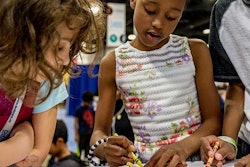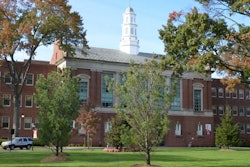On the list of sundry questions about how to meet her goal of becoming a thriving, tenured academic, Dr. Minoli Perera wanted to know just how to set up a scientific laboratory, manage it and balance those tasks against a bevy of other obligations, both professional and personal: teaching, advising students on college courses and post-college careers, doing her self-directed research and publishing the results — all while meeting the needs of her spouse and their two offspring, now preschoolers.
When she enlisted the University of Chicago and Northwestern University’s joint project to increase the tally of female professors tenured in the science, technology, engineering and math fields — ensuring equality in the workloads they shoulder and their chances to stand in an ivory tower spotlight long occupied by their male colleagues — Perera was hopeful.
But she wasn’t entirely sure of what to expect from the series of workshops.
“I signed up partly out of a curiosity to see what I could learn — as a kind of networking opportunity — from others who were senior to me,” said the 30-something University of Chicago assistant professor of medicine. “The other part of it is that while we have a lot of instructional mentoring on the science, career advice is given, but I needed it to be more available.”
While women have been increasingly finding their place as STEM professionals, that has been an unsteady trend. Some have enrolled in Ph.D. programs but dropped out. Others, meanwhile, are left to ask: After gaining tenure, what to do next? How does one thrive as a tenured professor with the same ease, efficiency and longevity of career as their male counterparts?
“Particularly at institutions like Northwestern and the University of Chicago, we’re likely hiring folks because they’re potential stars in their research, in their own discipline,” said Dr. Katherine Faber, a materials science and engineering professor at Northwestern. “Women candidates often have learned to conduct research very well in their grad programs, but they often have not learned some of the subtleties that are necessary to achieving tenure. That may be something as simple — or complicated — as how to run a laboratory or mentor a student in the same way that you were mentored. How do you find a mentor for your own career? These are not the things we teach in graduate school.”
Keeping Careers on Track
Announced in mid-January, the STEM collaboration is slated to run for three years. It is divided into two tracks, one for those seeking tenure and a second for non-tenured junior faculty members, said Faber, who had co-directed Northwestern’s pre-existing Navigating the Professoriate program since its 2007 launch.
The collaboration’s topics include: career-planning; how to deal with journalists; mentoring; management skills; applying for research grants at a time when those dollars are fewer; how to negotiate everything from salaries to committee to class assignments to getting a lab assistant; the tenure process, step by step; and how to keep momentum going after becoming tenured.
“We want to be able to ensure that our female faculty do this well. And there is a great deal of evidence that women are much poorer negotiators than their male colleagues,” Faber said.
“For many of women faculty, in general, the No. 1 concern is that they fear isolation,” said Dr. Mary Harvey, University of Chicago associate provost for program development, citing her institution’s recently published “Report on the Status of Academic Women.” “They also feel they do much more service work than their male colleagues, advising and mentoring and running committees in the departments. Ultimately, putting so much time into those other areas affects their research capability.”
The STEM collaboration is both a networking and a support system, partly aimed at mitigating risks that women will start but not finish a Ph.D. program. The National Science Foundation has spent roughly a decade funding similar bids to shore up female STEM aspirants but the Illinois collaboration is a rare cooperative by two mid-sized research universities. The two schools applied for but did not receive an NSF grant, said Dr. James Young, associate provost for faculty development.
“But both institutions were committed to this issue,” he said. “We also found that this is a way in which we could work synergistically to develop programs that benefited both institutions” and share the financing.
In 2010, of tenure-track women in STEM fields at the University of Chicago, 23 percent were in the basic biological sciences, 10 percent in the physical sciences and 29 percent in the social sciences. At Northwestern, 20 percent were in the biological sciences, 11 percent in engineering, 14 percent in the physical sciences and 36 percent in the social sciences, the institutions report.
While women constitute up to 30 percent of the faculty in various biological sciences at Northwestern, their numbers are substantially lower in the physical sciences and engineering, Young added. “In some of our [STEM] departments, less than one-tenth of the faculty are women. That creates difficulties in a variety of ways.”
He continued: “Departmental activities may be geared more to male schedules than female schedules; and even today, women are more likely to be involved with child care. Faculty meetings scheduled in late afternoon or evening can pose difficulty for women who prepare meals for their families. Other work-life issues where we’ve had problems, in the past, involved [women] faculty who needed maternity or child care leave.
“Diverse populations,” Northwestern’s Faber said, “bring a diversity of ideas to the discipline. If we are looking for creative solutions, we want as diverse a population as possible working on these problems. But if we look at engineering, which I know better than the life sciences or physical sciences, we’ve seen female enrollment peak and then it declined.”
Dr. Peggy Mason, who teaches neurology at the University of Chicago and heads its committee on neurobiology, said, “In some circles, there is a definite awareness that we’ve been missing the boat on advancing women. That has led to purposeful, intentional effort to be more inclusive.”
Between the two campuses, thus far, roughly 100 women have participated in the program. “We’re showing them options,” Mason said.
Tenure is very much a part of that, she said. But, beyond tenure, what are the prospects of running an academic STEM department, national laboratory or, say, a biotech company?” Perera said her sights are strictly on winning tenure.
The collaborative’s workshops, she said, have been invaluable and provided several ah-ha moments.
“I thought I was just supposed to do it all by myself, and that, miraculously, that’s how everyone else before me had done it,” said Perera, who teachers pharmacology and whose research focuses on the pharmacogenetics of Black peoples.
“I realized that all things are negotiable. And that, as women faculty, we often feel quite honored when we’re asked to do anything,” she added. “What we don’t see is that while it might seem great, initially, to teach another class if asked, juggling that next thing might not be such a viable option.”
“At one point, I had taken on teaching a pharmacology class, and it was a lot. I needed to know how to keep the lab going while I was away from the lab. It wasn’t that my adviser at the time didn’t want to give me that lab assistant. It’s that nobody taught me how to ask for that. When it I finally brought it up, it was, ‘Oh, yes, we have to — and are glad to — give you that support.’”


















